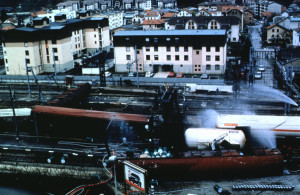A 28-railcar convoy, with 3 cars carrying hazardous substances, derailed at 2:25 am right at the train station in the middle of the city, just a few tens of metres from the closest residential buildings. The 11-kV drop in cables on the overturned railcars triggered the ignition of a 20-tonne tank of dimethylamine (DMA). 20-metre high flames were observed; moreover, 2 nearby cars contained 40 tonnes of ammonia (NH3) and 20 tonnes of methyl ethyl ketone (MEK). Some of the catenaries were ripped out, while others were deformed by the heat.
Notified at 2:30 am, a team of 50 fire-fighters arrived at the scene 7 min later with the appropriate foam. The fire was extinguished at 3:50 am, but a malodorous cloud led authorities to: introduce a 400-m safety perimeter, order the evacuation of buildings in the vicinity, and request all other neighbours to remain indoors. The cloud was diluted with a water curtain. A leak ultimately identified around 5 am on the DMA railcar was only precisely located on a flange of the damaged drain 5 hours later. An Operational Control Station was set up at 10:30 am, at which point the Prefect activated the TRANSAID procedure. As of the beginning of the following afternoon, both the municipality and prefectural departments regularly informed the population either directly or through distributing flyers.
Emergency services were unable to install a new flange without the assistance of specialists, who were being actively sought. By 5:30 pm, the leak was 95% plugged. A customised “bell” was installed on 17 March at 6 pm for the purpose of better controlling the residual emissions. Sprinkling of the tank was halted, and the DMA caught by the bell was neutralised by dissolution in water.
After a full day of assessing the situation, all onsite transfers were stopped; the DMA car from then on was to be raised and moved t a safer place within the special convoy. These operations were prepared down to the finest detail, then the DMA car was raised on 18 March at 6:10 pm and removed at 8:24 pm onto a lower-level platform 20 km from the accident site; since the convoy was unstable, the journey lasted nearly 3 hours at 8 km/h. The car was then placed upright on 19 March and cooled with carbon dioxide (CO2) in order to balance the pressure and void using an immersion rod. The slightly-damaged car carrying NH3 would be towed to its final destination.
Thanks to an overall favourable context, as well as the tank design and quick response time by the emergency services, the accident exerted no major impact on the environment, although the municipal treatment plant was minimally polluted by runoff water through the stormwater drainage network. Trains were allowed to resume circulation on 20 March around 6:30 pm.
Six cars left the track (nos. 3 through 8). The 3rd of these, a two-axle grain carrier, empty and intended for the scrap yard, derailed 1 or 2 km from the station. Arriving out of alignment, this car slammed into containers and docks, causing derailment of subsequent cars.
This accident highlighted, at the very least, the need to draft as quickly as possible Specialised Emergency Plans for the Transport of Hazardous Substances, as indicated in the pertinent regulations (Circular 88/404, issued 22 November, 1988).
The Transport Ministry assembled a special public investigation commission in order to determine/analyse the causes of this accident and draw lessons in the area of prevention and organisation of rail transport system for hazardous substances. Some 30 recommendations were relayed to the rail operator in order to:
- define preventive measures on the equipment and track to avoid derailment risks and ensure their rapid detection;
- improve the safety of hazardous substance transport;
- build an assessment of the factors leading to derailments (through both a theoretical approach and feedback);
- help clarify responsibilities of the various actors in the handling of serious accidents;
- participate actively in the development of emergency plans, within the scope of the action plan initiated by the Interior Ministry
Download the detailed report in .pdf format (1.1 Mb)





